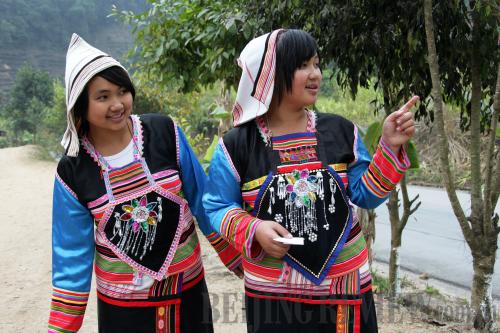|
Industrial and agricultural growth
 |
|
AFFORDABLE EDUCATION: Zhou Xiaoting (left) and Zhou Xiaole, two sisters of the Jinuo minority group, walk along a road near their hometown in Yunnan Province. The Western Development Strategy allows the sisters to study at a vocational school tuition-free and lead a life similar to their urban counterparts WANG XIANG | Frequent droughts and an obsolete agricultural production mode once forced Ningxia to import grain from neighboring provinces and regions. But now, Ningxia's per-capita grain production is 536.2 kg and the region has become one of five in China that produces more than 500 kg grain per capita. Ningxia has since become self-sufficient with its grain needs.
The Central Government's call for improvements to agricultural production conditions as part of the Western Development Strategy has helped modernize agriculture at the local level. Ningxia responded by promoting water-efficient agriculture and protected agriculture, a method of growing crops in a controlled environment.
Ningxia's new agricultural production mode has been replicated in other western provinces and autonomous regions.
NDRC statistics from the past 10 years show output increases of major agricultural and pastoral products, as well as the stable development in the western region's agricultural and rural economies.
The gross output value of the farming, forestry, animal husbandry and fishing sectors reached nearly 1.5 trillion yuan ($220 billion) in 2008, increasing 911 billion yuan ($133.4 billion) from 2000, or 158.3 percent, while grain output rose 8.5 percent from 129 million tons in 2000 to 140 million tons in 2008.
Animal husbandry accounted for a majority of the region's agricultural production, with meat, egg and milk production increasing by 24 percent, 39 percent and 357.8 percent, respectively.
The industrial sector has also picked up steadily. According to the Ministry of Industry and Information Technology, the added value of the industrial sector in the western region was 2.25 trillion yuan ($329.4 billion) in 2008. The region realized a sustained annual growth of 22.96 percent in average from 1999. According to NDRC statistics, the industrial added value accounted for 38.7 percent of the region's GDP and 47.7 percent of GDP growth in 2008, increasing from 19.5 percent and 25.7 percent in 2000, respectively.
While relying on its unique resources and making use of its comparative advantages, the western region has formed some competitive industries with local characteristics, according to the NDRC's Western Development Office. The dairy industry and cashmere products of Inner Mongolia, tobacco production of Yunnan, sugar making of Guangxi, quality cotton growing and fruit and vegetable processing of Xinjiang all have received a boost from the strategy, says the office.
Other provinces or regions are enjoying competitive advantages in raw material production, such as lead and zinc in Gansu and Yunnan, vanadium and titanium in Sichuan, rare earth in Inner Mongolia, potash fertilizer in Qinghai, and phosphorus fertilizer in Guizhou.
Ecological action
"In accordance with the Western Development plan, we took the lead in launching the natural forestry protection engineering project," said Wei Hong, Vice Governor of Sichuan.
The project has covered 19.2 million hectares of natural forests in the past few years. The province has also reclaimed 1.85 million hectares of forests from farmlands and 5 million hectares of grasslands from grazing lands, Wei said. Currently, the province has 123 natural reserves, accounting for 15.8 percent of the province's total area, and boasts a forest coverage area of 30.8 percent, 6 percentage points higher than in 2000.
"Projects, such as reclaiming forests or grasslands from farmlands, and natural forest protection, are a requirement of the Western Development Strategy and through these measures we aim to improve the local environment and prevent further damage to the ecosystem," according to a statement by the Western Development Office of the NDRC.
| 